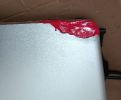Blue House Computer Help
Active Member
- Reaction score
- 29
- Location
- Cambridge, UK
So I have a problem and I'm wondering what you would do in my situation.
I had a customer bring in an expensive (for me) laptop for repair. One of the hinges had broken away from the rear case (the plastic screw mountings behind the screen) and in the process had wrecked the lcd panel. Unfortunately, I could only get a replacement LCD from China, and it took weeks to arrive, because it got unfairly held up in customs for VAT (tax charges) which I had already paid through Ebay when I bought it.
The customer was getting more and more desperate, and I finally managed to get the screen and work on it last Thursday. However, this laptop has really tiny screws that mount the hinge to the palm rest and, perhaps because of all the stress of the screen hanging the the other hinge for an extended period, it broke away from the palm rest mounting the while I was trying to disassemble it. Since I discovered it as I was disassembling it, I honestly have no way of knowing if it was something I did, or if it was already broken underneath, or had already been weakened and this was just the final straw.
When I spoke to the customer about this, she decided to bail out of the repair and claim the laptop on her home insurance as not economical to repair. However, if I have to return the parts, including sending the screen to China and she pays nothing (since it wasn't fixed), I'm going to lose out on about £60, and about 3 hours labour up to this point, plus the time to repack and ship bits back. As far as I can see, I would have to replace the palm rest at a further cost of about £120, which, since I was unsure whether it might have been me who broke it, I offered to pay. However, she's going with claiming the insurance money and going out to buy a new laptop.
It seems unfair and difficult to collect to ask her to pay for the time accrued so far, since I'm not delivering back a fix laptop. I haven't specifically discussed a no-fix, no-fee with her, but that seems to be the assumption she's working on so far. So far, I've been cooperating with her in terms of setting information together for the insurance claim, but I do feel a certain amount of unresolved tension.
There are a few more interesting details to the story, but this should be enough to get the gist of the situation so I'll leave it at that and add more if needed.
Pragmatically speaking what would you do in this situation? Charge for the parts and/or labour anyway? At least charge a restocking fee? What could I legitimately charge her for? I guess there's a question of actually getting her to pay it, really.
I had a customer bring in an expensive (for me) laptop for repair. One of the hinges had broken away from the rear case (the plastic screw mountings behind the screen) and in the process had wrecked the lcd panel. Unfortunately, I could only get a replacement LCD from China, and it took weeks to arrive, because it got unfairly held up in customs for VAT (tax charges) which I had already paid through Ebay when I bought it.
The customer was getting more and more desperate, and I finally managed to get the screen and work on it last Thursday. However, this laptop has really tiny screws that mount the hinge to the palm rest and, perhaps because of all the stress of the screen hanging the the other hinge for an extended period, it broke away from the palm rest mounting the while I was trying to disassemble it. Since I discovered it as I was disassembling it, I honestly have no way of knowing if it was something I did, or if it was already broken underneath, or had already been weakened and this was just the final straw.
When I spoke to the customer about this, she decided to bail out of the repair and claim the laptop on her home insurance as not economical to repair. However, if I have to return the parts, including sending the screen to China and she pays nothing (since it wasn't fixed), I'm going to lose out on about £60, and about 3 hours labour up to this point, plus the time to repack and ship bits back. As far as I can see, I would have to replace the palm rest at a further cost of about £120, which, since I was unsure whether it might have been me who broke it, I offered to pay. However, she's going with claiming the insurance money and going out to buy a new laptop.
It seems unfair and difficult to collect to ask her to pay for the time accrued so far, since I'm not delivering back a fix laptop. I haven't specifically discussed a no-fix, no-fee with her, but that seems to be the assumption she's working on so far. So far, I've been cooperating with her in terms of setting information together for the insurance claim, but I do feel a certain amount of unresolved tension.
There are a few more interesting details to the story, but this should be enough to get the gist of the situation so I'll leave it at that and add more if needed.
Pragmatically speaking what would you do in this situation? Charge for the parts and/or labour anyway? At least charge a restocking fee? What could I legitimately charge her for? I guess there's a question of actually getting her to pay it, really.

